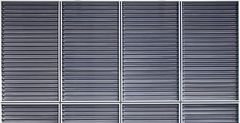The research project for the integration of solar thermal (vacuum tube collectors) in façades concerns the energy in modern office façades. Heat captured with the façade collector delivers solar energy, which can be used for variously for water heating, solar cooling and to augment interior heating. In addition to the solar thermal activation of the building envelope, a system was developed which allows optimal daylight and sun shade control.
The façade panel was created as part of the BMU-funded project "Development of solar thermal façade panels with vacuum tubes in office buildings (FKZ 0325956A)". The integrated façade collector is a positive example of networking knowhow. The companies involved, Ritter Energie- und Umwelttechnik (Energy and Environmental Technology) GmbH & Co. KG, Hydro Building Systems GmbH (WICONA), and Frener & Reifer Metalbau GmbH worked together with the Institute for Building Construction and the Institute for Thermodynamics and Thermal Engineering at the University of Stuttgart as well as the Chair of Technology and Design of Building Envelopes at TUM. A further Partner was Solites, a research institute for solar and sustainable thermal energy systems.
The CPC Office / System WICONA façade collector meets the future requirements for sustainable modern office buildings with glass façades. The important technical aspects, such as visual transparency, evenly dispersed lighting, heat insulation, and sun protection are combined in a unique way by this product. The CPC vacuum tube collector (Ritter) constitutes an aesthetically and structurally integral part of an office façade system (WICONA). Behind the vacuum tubes is a perforated mirror aligned to the sun, which on the one hand effectively draws the radiation onto the absorber layer of the tube, and on the other ensures transparency in the façade. In addition to this selective transparency and the optimized utilization of solar ra diation, it provides a sun protection function, which prevents glazed office buildings from overheating. The overall objective of the collaboration was to further evolve and improve the technical specifications of the developed façade collector as a small series using the so-called ‘Sydney-Tube’.
Of particular importance here, besides energy gain, cleaning and safety in the event of damage, were detailed investigation s into the use of daylight and the sun protection function of the façade collector. The investigations into daylight were carried out by the Chair of Technology and Design of Building Envelopes at the solar station in the Technische Universität München (TUM).
The exact optimization of daylight on the one hand and the testing of efficient sun protection on the other were the main foci of a series of in situ measurements. In the interplay between transparency, light transmission and efficiency of the collector, the accurate tuning of the effective area was examined in relation to the inspection surface by means of an iterative process. The effective area denotes the area which is illuminated directly by the sun. More specifically, different perforations of the mirror were studied in its capacity as a sunscreen, as well as the efficiency of the energy collector unit.
Conclusion:
The technical aspects such as visual transparency, evenly dispersed lighting, heat insulation and sun protection are combined in the façade system. The CPC vacuum tube collector (Ritter/Paradigma) constitutes an integral part of an office façade system (WICONA). According to Prof. Volker Wittwer of the Fraunhofer ISE Institute in Freiburg, the system meets the future requirements for sustainable modern office building with glass façades.
Solar Thermal Energy in the Façade
